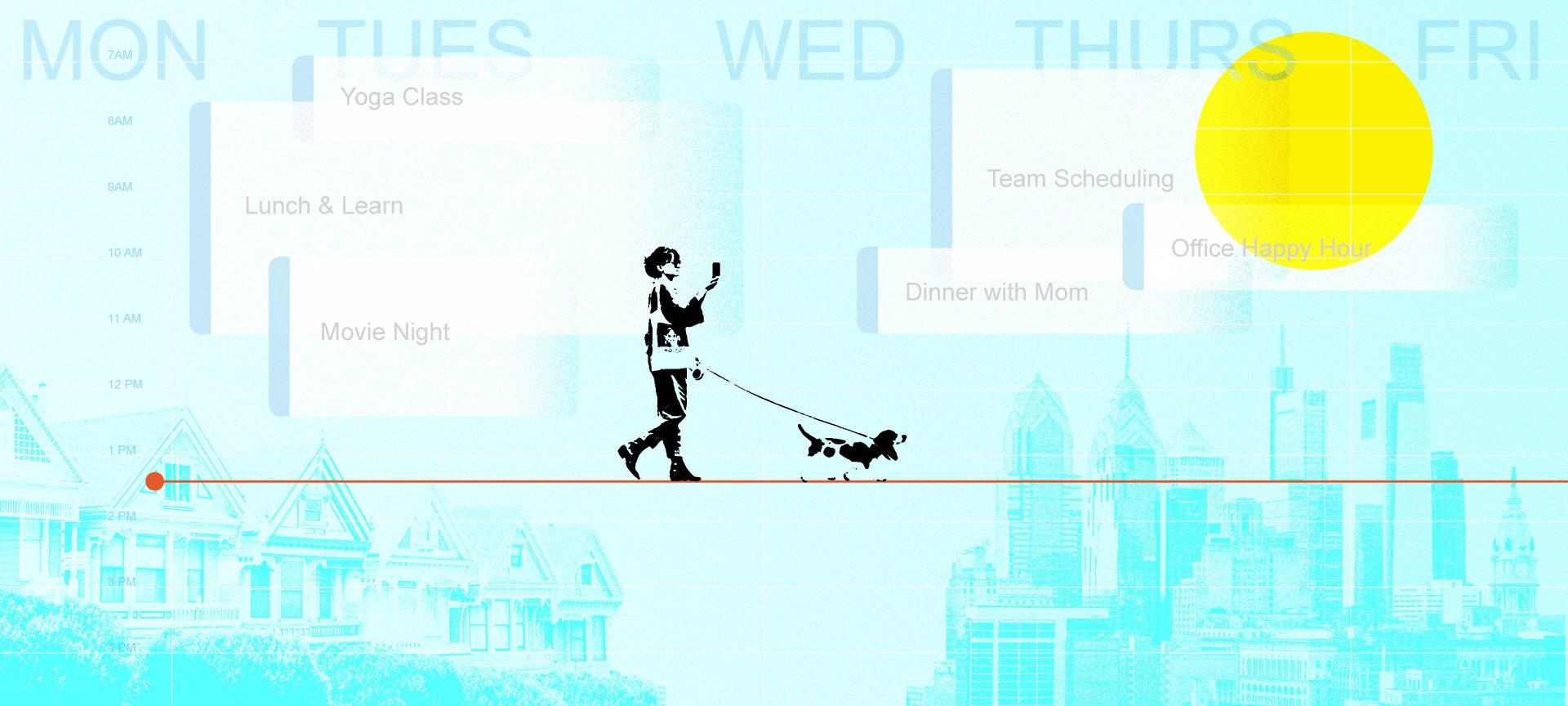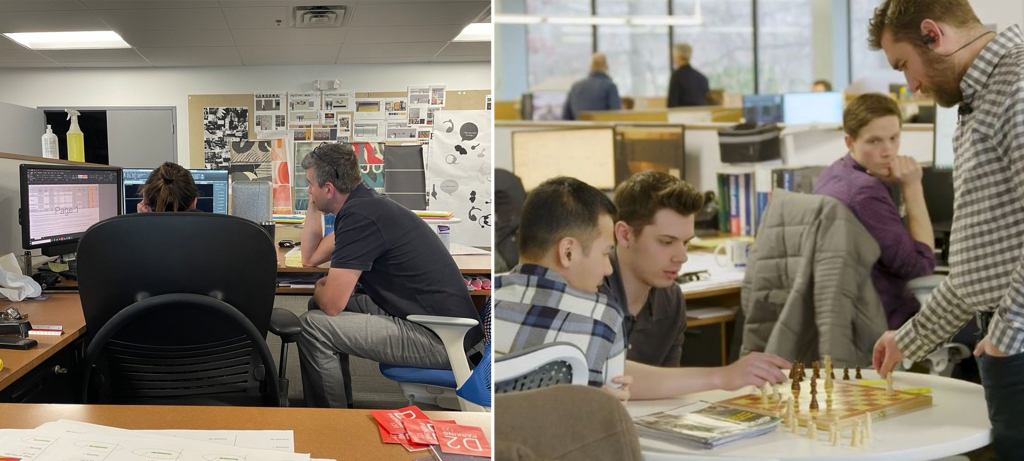
How We Designed Our Return to the Office and How You Can Too
In this article we’ll briefly share the highlights of our new workplace policies and why they…work for us. Then, we’ll share the best RTO advice our team has to offer so you can confidently develop your own plan!
Our office officially re-opened its doors in June of 2021. For us, being together this summer proved to be a win-win. Was it an adjustment for all? Yes. Nerves? Definitely. Now, however, most on our team appreciate the office and the home equally for the unique benefits they offer. Many simply prefer the office – which is a welcome surprise!
We kicked off our return with an all-hands meeting, starting with an opening welcome by our own Eddy that rivaled the best wedding speech! We spent some time on a review and discussion of our safety policies and a detailed refresher on our flex-work policies. Round the room we went to meet all our new teammates who had joined D2 during quarantine. We ended on a light-hearted note with a team building exercise. All this over some good coffee with great – and much missed – friends!

THE ‘RIGHT’ SOLUTION?
Finding the policy that sits comfortably between healthy workplace culture and achieving business objectives is critical…and challenging. Yet, as we continue to work with clients planning their RTO policies, and with our own under our belt, we can see the future more and more clearly. The hybrid model – a mix of working from home and working in the office – is a viable solution for almost all businesses. The tricky part for leaders is defining exactly how the hybrid model will be applied– Manager discretion? Defined ‘in office’ days? Focus work at home, collaboration at the office? Pick your days? Assigned desk seats? Unassigned desk seats? One, Two, Three…Four days at home? Scrap the 9-5? The possibilities are seemingly endless!
The tricky part for leaders is defining exactly how the hybrid model will be applied– the possibilities are seemingly endless!
OUR RTO STRATEGY
So, let’s reel this in a bit and focus on the policy we found ‘just right’ for our studio. That’s right – we went with a hybrid model! Here’s why and how we uniquely define it in two, simple strategies:
Fixed Days. So, we knew we had to be together. But not at a mostly empty office that would make one wonder why they commuted in. These two basic needs led to the creation of three common days in the office and two at home. On our three ‘Collaboration Days’, we’re all together. We schedule meetings on these days, we move around the office to socialize, provide feedback, and be available to those who need us. We build consensus, we define responsibilities, and we collectively make decisions. On our two ‘Focus Days’ we keep meetings off the calendar (where possible, of course!). And we get the sweet, sweet sound of silence that allows us to tackle our to-do list, think uninterrupted, and breathe deeply.
Flexible Hours. A lot of us have kids. And hobbies. And like seeing the sun in winter. We like to take care of our work and ourselves. Is the 9-5 dead? Not for all businesses, but for us it’s no longer the law (admittedly, it never really was). We’ve always operated with flexible policies and now we’ve expanded them. Working toward a Wednesday deadline yet hoping for some R&R on Tuesday? Cool, then get the job done Monday. If we’re responsible in our communication, our work stays awesome, and our clients are happy, flexibility is always welcome.
We’ve always operated with flexible policies and now we’ve expanded them.
WHAT WE’VE LEARNED.
No policy is without issue. For this reason, it shouldn’t be too complex to evolve as we all find our feet on this new ground. We don’t claim our policy is perfect and can’t expect it to fit every life and work style. Over these last few months, we’ve fine-tuned and further communicated our policies based on the feedback we’ve received from our team. In fact, their feedback is so good, we asked them for more. Here is the best advice they have for leaders planning or implementing a return policy and for employees who are anxiously anticipating the roll out of that policy or trying to settle into it now.

TO ALL THE EMPLOYEES OUT THERE:
Going back to the office can be a truly positive experience. Personally, I get anxious when I’m not with my team – I worry that I’m not fully aware of any possible shifts, the latest details, and that I may be missing out on opportunities to get involved! So, for me, returning to the office was a huge relief. I also feel that I’m more productive at the office for certain tasks – so having the ability to go in, even on WFH days, is a great benefit! – Danielle Trotter, Graphic Designer
A hybrid schedule can further complicate the true beginning and end of the workday. It’s easy to access work from anywhere and at any time. Endeavor to make it just as easy to log out/disconnect. Be intentional about putting your work down. The end of the day could be when you meet your deadlines or when you find a good stopping point to return to later. – Brian Davis, Project Designer
Really take advantage of any flexible schedule opportunities you have. These policies are there for your wellbeing, take care of yourself. And stay positive! Things are constantly changing around us and we have little control. If you head back to work with a positive attitude, it will help you readjust. – Eddy Etotok, Electrical Engineer
Identify what benefits you most. While at the office, try to prioritize that type of interaction while you’re there rather than having the same routine and schedule every day. Making your home vs. work activities distinct will help bring structure to your week. – Jess Badolato, Business Development
Having access to your team in the office is a gift. Take advantage. Take any opportunity to pull a teammate aside and get their feedback. Also, be vocal and be an advocate for yourself. If something isn’t working, or you don’t feel you were given the proper tools to balance a hybrid schedule, then make sure you communicate. Your managers likely have different struggles, so they may not see yours. – Nicole Belletti, Project Designer
Working from home is reality so approach your home workspace seriously. If you can’t separate it from your living areas, take the time to organize and put away all work-related material when you are done for the day. When my dining room table was my only option, leaving out paperwork/laptop/drawings at the end of the day made it feel like I never left the office and destroyed the work/home separation that is needed for mental health and relaxation. – Jon Auman, Mechanical Engineer
Try to stick to a disciplined routine. I make sure to go to bed and get up at roughly the same time, get dressed, eat breakfast – regardless of whether I’m going to work or staying home. Every night I go through a list in my head of everything I need to pack for the following day and get that ready to go so when I wake up groggy in the AM, it’s already by the door and I can just grab it and go. – Robby Prall, Director, Brand Identity
TO ALL THE LEADERS OUT THERE:
Make sure the physical workplace supports the way your employees work now and in the future. If the existing HQ is full of offices and workstations, yet the purpose of the office of tomorrow is about collaboration, there WILL be friction. – Linda DiEgidio, Project Manager
Ease your people into the transition. It’s REALLY jarring to face traffic again and map out your day when you’re used to full flexibility. Try to make all transitions slowly. It’s amazing how quickly little things can add up and create stress. Also, maybe ease up on your dress code if it’s rigid. I can’t imagine going from tees to ties! – Robby Prall, Director, Brand Identity
Your employees are anxiously awaiting policy announcements. Ideally, you have been open to discussions with your team throughout the pandemic. If so, your policy won’t be a surprise to them. But the decisions you make will still personally affect your employees in all facets of their life. Unfortunately, some employees may strongly disagree with small (but highly important to them) pieces of the policy This may be the biggest change many of your employees have experienced with your company so really consider your unique team and design your policies to support them and your business equally. – Lauren Coughlin, Director, Strategy + Culture
Give the best of both – a hybrid policy brings balance. WFH only is boring and lonely, while WFO only greatly limits flexibility. Keeping both and developing the policies to manage it correctly will lead to happier employees who are more willingly engaged with their work. – Amir Ghorbani, Project Designer
Listen to what your employees are saying. Ask them how they are feeling and what they are thinking…and do it often. You can’t please everyone, but I think it’s important to really listen to what everyone has to say before making decisions. Also, policy evolution is ok, abrupt change is not. Stability is critical to reduce apprehension. Don’t announce a plan until you are confident it is final. – Eileen Olseski, Marketing Coordinator
We need healthier habits moving forward. Consider allowing kids and dogs at the office. Encourage employees to stay home if they’re sick. Come up with some creative new initiatives to help your employees stay well! – Kalee Holdren, Project Designer
Keep an open mind. Anything is possible and solutions ‘right’ for others aren’t necessarily ‘right’ for your company. I am admittedly biased, being in the workplace design business, that people need to go back into their offices at least for a few days a week! My real advice, however, is really for everyone – not just leaders – both decision makers and the employees of businesses should be flexible and open to trying different solutions. – Lyndsi Dengler, Director, Environmental Branding
We hope you enjoyed our account and our team’s advice! We’d love to share more about our personal experience and how we’ve helped many clients navigate their way to a highly successful return. Reach out to Jess Badolato to connect!
